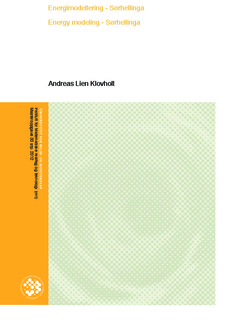| dc.description.abstract | Denne masteroppgaven omhandler energibruken ved undervisningsbygget Sørhellinga som opprinnelig stod ferdig desember 1979. Sørhellinga fikk tidlig problemer med store energikostnader og et rykte på seg for å ha et dårlig inneklima. Problemene ble forverret grunnet en stadig økende brukergruppe og overbelastning av underdimensjonerte ventilasjonsaggregater. I 2004 startet derfor rehabiliteringsarbeidet og juni 2008 stod Sørhellinga ferdig rehabilitert og delvis ombygget. Tross et hovedfokus på energibruk og inneklima bruker Sørhellinga store menger energi og folk klager på inneklima ved flere av byggets arealer. Våren 2011 ble bygget utgangspunkt for masteroppgaven ”Energiledelse og energieffektivisering i bygg”. Oppgaven fokuserer på byggets drift og styring som hovedgrunnen til det store energibehovet. Det ble konkludert med at deler av byggets høye energibruk skyldes drift og styring, men at det må være andre forhold som også ligger til grunn for energibruken.
Denne oppgaven bygger videre på oppgaven fra våren 2011, og søker å finne flere grunner til byggets høye energibruk. Studier av byggets bygningsfysikk og tekniske installasjoner har vært utgangspunkt for oppgavens fire hypoteser. Oppgavens teoridel består av informasjon om bygget, samtaler og intervjuer med aktuelle aktører og teori som bygger opp under hypotesene. For å modellere bygget og svare på hypotesene har programvaren Simien blitt benyttet for energisimuleringer. For å simulere bygningsdetaljer har programvaren Therm blitt brukt.
Resultatene viser at byggets bygningsfysikk, ventilasjonsaggregatenes soneinndelinger og valg av laboratoriearealer bidrar unødvendig til det store energibehovet. Drift og styring av bygget har også behov for effektivisering før bygget er energi-optimalisert. For å oppnå et forbedret inneklima må det gjøres endringer med ventilasjonsaggregatenes soneinndelinger. I løpet av perioden denne oppgaven er skrevet har DSA besluttet å gjøre om på soneinndelingen.
Studiet konkluderer med at bygningsdetaljer og valgte løsninger bidrar til byggets høye energibruk og dårlige inneklima. Alternative løsninger burde i flere tilfeller vært valgt. Samtidig må DSA fortsette å jobbe for ytterligere forbedret drift og styring. This master thesis deals with the energy use of the university building Sørhellinga, which was originally built in 1979. The building soon was assosiated with a poor indoor climate, and had big costs regarding its energy use. The extent of the problems increased over the years due to an inadequate dimensioning of the ventilation units, as more and more people were visiting on a daily basis. Because of this, rehabilitation of the building was commenced i 2004, and the building as it appears today, both rehabilitated and partly converted, was finished in june 2008.
Despite a focus on use of energy and indoor climate, Sørhellinga still uses a lot of energy, and some people are still complaining about the climate in several of the building areas. In 2011 the energy use of Sørhellinga was the background for a master thesis about energy efficiency. The thesis concluded that the main reason for the big energy demand of the building is the way it is managed and operated. It also concluded that in addition to these factors, there must be other reasons for the energy demand.
This thesis is a continuation of the mentioned thesis from last year, and seek to find the additional reasons for the big energy use of Sørhellinga. Four hypotheses are presented in this paper, based on studies of the building physics and technical installations of Sørhellinga. In the theory part, information regarding the building itself, information about relevant theori for the hypotheses and rendering of interviews with people associated with engineering and managing of the building, are presented. The softwares Simien and Therm have been used to simulate different physical and technical conditions.
The results show that the building physics, the design of ventilation units and the space used for laboratories in Sørhellinga are contributing unnecessarily to the energy demand. Also the managing and operation of the building need some improvement in order to reach a sufficient energy use. Since my work with this thesis started, the service unit of the university has decided to rearrange the design of the ventilation units.
The final conclusions are that building physics and operational design contribute to the big energy use and poor indoor climate of Sørhellinga. Different solutions might give improved conditions in several cases. In addition, the service unit need to focus on more efficient operation. | no_NO |
